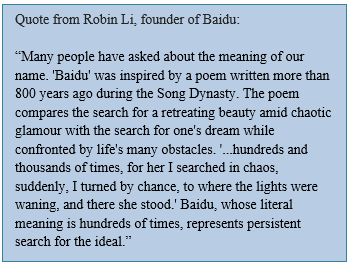News & Updates
Lotus - A trusted name in family travel
The move away from the “planned economy” into allowing market forces affect the economy was referred to as capitalism “with Chinese  characteristics. It seems that this phrase could also be applied to the use of the internet in the world’s largest market. China has witnessed an explosive growth in the number of online users, and specifically, social media users in the last few years. With more than 800 million internet users—and counting – the internet is fundamentally altering the fabric of daily life in China. Here is a broad overview of the key online tools used by Chinese netizens organized by category.
characteristics. It seems that this phrase could also be applied to the use of the internet in the world’s largest market. China has witnessed an explosive growth in the number of online users, and specifically, social media users in the last few years. With more than 800 million internet users—and counting – the internet is fundamentally altering the fabric of daily life in China. Here is a broad overview of the key online tools used by Chinese netizens organized by category.
Social Media Landscape
Social media platforms in China are more domestic than global. Though there are many foreign users of these websites, they are more tailored for the Chinese market. The main services dominating the market are Weibo (microblogs), instant messaging tools (IM) and social network services (SNS). Blogs and blogging services are not so prevalent. If adoptive parents or adoptees wish to communicate and make contact with individuals living in China, knowledge and use of some of these tools is quite useful.
Social Network Services (SNS)
Similar to Facebook and LinkedIn, SNS platforms in China provide online communities for netizens to post, share and exchange information.
RenRen & Kaixin
Websites: www.renren.com/
Renren has been called the “Chinese answer to Facebook” and has an estimated 194 million users. RenRen was originally called Xiaonei (which means campus) and was initiated in 2005. It tends to be used by students and teens. Though Facebook can be accessed via Virtual Private Networks (VPN) to bypass the “great firewall of China”, Facebook reports that its market share in China is “almost zero”. Kaixin is also a Facebook-like social network with 113 million users. Unlike RenRen, Kaixin’s target market tends towards the older generations, and white-collar workers.
 Weibo (meaning microblog) is a Twitter-esque platform enabling users to post short messages. The top two Weibo services in China are Sina Weibo and Tencent Weibo. Microblogs or Weibos are a very popular communication format in China. People tend to place more trust in the information they find there than other online sources. They also use Weibos to write Wei Xiao Shuo – micro novels. The top four sites have reached 97 per cent of social media users and are fast becoming the preferred social media channels. Sina Weibo, which is akin to Twitter, is the dominant channel with the most active daily users.
Weibo (meaning microblog) is a Twitter-esque platform enabling users to post short messages. The top two Weibo services in China are Sina Weibo and Tencent Weibo. Microblogs or Weibos are a very popular communication format in China. People tend to place more trust in the information they find there than other online sources. They also use Weibos to write Wei Xiao Shuo – micro novels. The top four sites have reached 97 per cent of social media users and are fast becoming the preferred social media channels. Sina Weibo, which is akin to Twitter, is the dominant channel with the most active daily users.
Sina Weibo
It is very similar to a hybrid of Twitter and Facebook and is one of the most popular sites in China. It has an estimated 600 million registered users in About 100 million messages are posted each day on Sina Weibo.
About 100 million messages are posted each day on Sina Weibo.
• Twitter-like blog that enables users to post up to 140 Chinese characters
• It is available in both simplified and traditional Chinese, and there is now an international version
 The Chinese instant messaging (IM) market is more diversified than that of its Western peers. Though most of the IM tools are no more than two or three years old, the number of users is growing rapidly. As a comparison, one of the most popular IM tools in the West, WhatsApp, announced in 2014 that it had exceeded 500 million active users, five years after its launch. In comparison, WeChat, one of the main IM services in China, achieved this figure within only two years. It is now estimated that there are 600 million users of WeChat. Although it’s similar to WhatsApp, it allows users to do more, combining features from Twitter, Facebook, Skype, Instagram and geo-location apps.
The Chinese instant messaging (IM) market is more diversified than that of its Western peers. Though most of the IM tools are no more than two or three years old, the number of users is growing rapidly. As a comparison, one of the most popular IM tools in the West, WhatsApp, announced in 2014 that it had exceeded 500 million active users, five years after its launch. In comparison, WeChat, one of the main IM services in China, achieved this figure within only two years. It is now estimated that there are 600 million users of WeChat. Although it’s similar to WhatsApp, it allows users to do more, combining features from Twitter, Facebook, Skype, Instagram and geo-location apps. WeChat Website: www.wechat.com/

Mobile QQ
Website: www.imqq.com/
User Base: 426 Million users
Live translation (50 plus languages); cross-platform integration
QQ is an abbreviation of Tencent QQ, a widely popular instant messaging service. By Last September, there were 784 million active user accounts with approximately 100 million online at a time. According to Alexa Internet rankings, the QQ website ranked 8th – moving it ahead of Twitter.
 Baidu is China’s most popular search engine and is somewhat similar to Google in that it allows advertisers space along with search results.
Baidu is China’s most popular search engine and is somewhat similar to Google in that it allows advertisers space along with search results.

Baidu offers several services to locate information, products and services using Chinese-language search terms. It uses search function by Chinese phonetics, advanced search, snapshots, spell checker, stock quotes, news, images, video and space information, along with weather, train and flight schedules and other local information.
Other Tools
Linked In or Jingwei
LinkedIn has just announced the launch of a version of the platform in Simplified Chinese. Even before the launch, the site had around four million users. Many of these users were educated in the west. It’s competing against a home-grown business network called Jingwei.com.
 Youku, means “excellent (and) cool”, and is the second largest video site in the world after YouTube. YouTube is one of the sites blocked by China. YouKu had 100 million visitor views in January 2013, which rose to 400 million by August. It racks up more than 1.3 billion minutes of viewing in one month alone. .
Youku, means “excellent (and) cool”, and is the second largest video site in the world after YouTube. YouTube is one of the sites blocked by China. YouKu had 100 million visitor views in January 2013, which rose to 400 million by August. It racks up more than 1.3 billion minutes of viewing in one month alone. .
In 2012 – the two biggest video online companies in China, Youku and Tudou, announced their merger - the name of the merged company is Youku Tudou Inc. The Chinese Government is currently trying to enforce a real name policy on its domestic online video sites.
Chinese media platforms have evolved with their own characteristics, though they have emulated the websites and functions designed by Western peers. The social media market is vibrant. Chinese people who own a smart device use it in greater proportion to access social media and communication tools than the US counterparts, with 91% of the online population of China having a social media account, compared to 67% of people in the US. China has by far the most Internet users in the world, and it appears that soon half the country will be on the web, thanks largely to cellphones and other mobile devices. It will play an increasingly important role in communication and information flow all over the country.
Sources: Cicero, Emicromedia, Emoderation, MGI China Digital, Wikipeda,